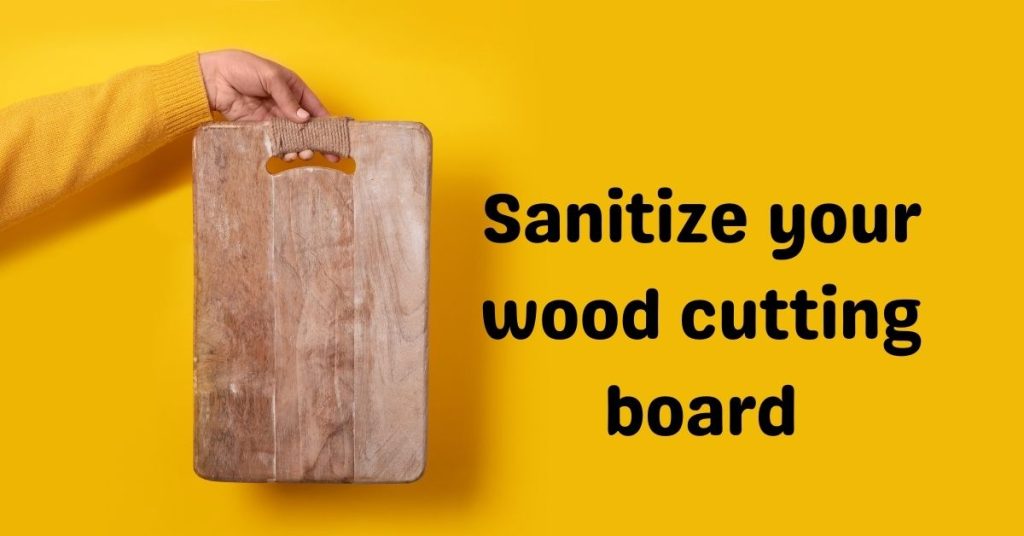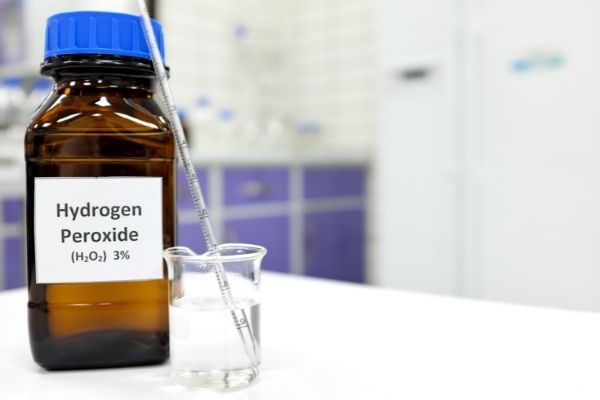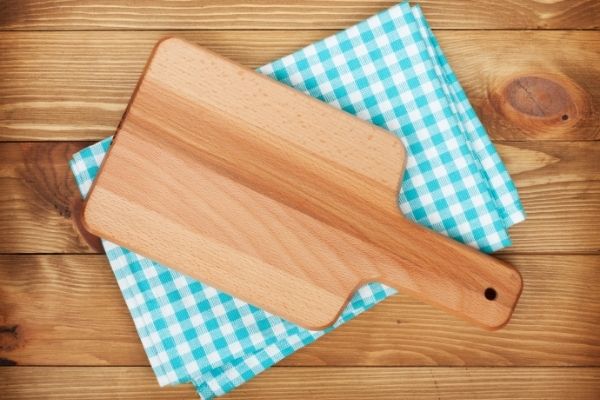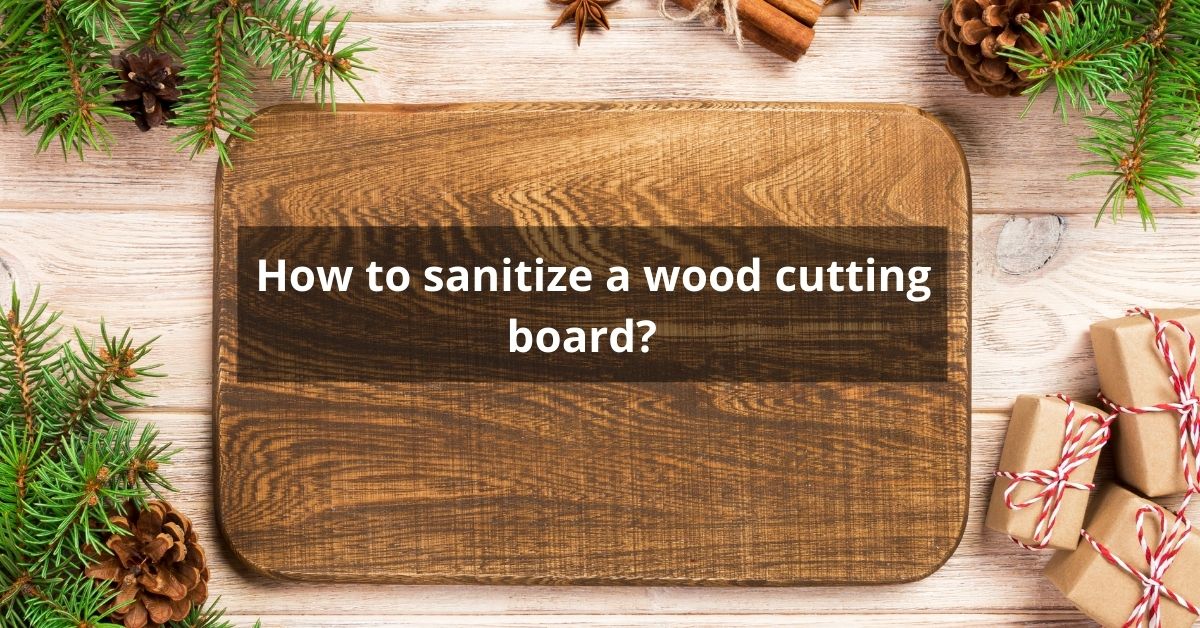A cutting board is essential for the kitchen. People use marble and plastic cutting boards in the kitchen, but a wood cutting board is a better option than marble and plastic cutting boards for many reasons. They are helpful, look very attractive, and are long-lasting if you keep them well-maintained.
Some ingredients pass through the cutting board in almost every recipe, so it needs to be clean and germ-free. Keeping a wood cutting board clean is easy, but a clean wood cutting board is not necessary to disinfect it. You will need to sanitize the board properly to ensure your health safety.
How to sanitize a wood cutting board? I will teach you the easiest ways for wood cutting board sanitization.

Step-by-Step Guide to sanitize a wood cutting board
Woodcutting boards are harder than plastic, which makes them excellent tools to use in the kitchen. But unlike plastic cutting boards, wood boards need to be cleaned and sanitized after each use.
You may have many sanitizing chemical options, but you need health safer products when it comes to sanitizing the wood cutting board.
Follow these steps to keep your wood cutting board clean and ready to use at all times.
Step 1- Arrange Supplies
You can use bleach, lemon juice, or vinegar. Gather all of your supplies and have them nearby. You will need white vinegar, 3% hydrogen peroxide, a stiff cleaning brush or sponge, dish soap, lemon juice, baking soda (optional), and a dry but clean towel.
- To sanitize with lemon juice, take one cup of water and one teaspoon of lemon juice. Fill up a sink with enough water so that your cutting board will be covered in it entirely.
- Alcohol kills 99% of bacteria and germs. However, it doesn’t work so well on deep stains.
- Baking soda is a mild disinfectant and can be used in place of bleach.
Take some time beforehand to familiarize yourself with all of your equipment, especially if there are any tools or products you’ve never used before. This can save valuable time down the road.

Step 2- Rub the Wood
When you have finished your cutting tasks, rinse off any food debris, never allow them to dry or stick to the board surface, it may be tough to remove. Take the stiff clean brush or sponge and apply the dish soap over the surface to remove the food particles. If necessary, sprinkle baking soda on the cutting board for a few minutes, but it is optional if food particles become dry; scrub it and rinse with warm water.
Step 3- Sanitize wooden board
Now your wood cutting board is clean, but it does not mean it is also disinfected; a clean board could have a lot of germs. So need proper sanitization, you have 3% hydrogen peroxide for this purpose. Pour it over the board, spread it gently over the surface using a clean sponge, and allow it five to ten minutes.

It will kill the germs after fizzing; this process is effective for the boards with small cracks because of the knife. Keep an eye over the fizzing when you see fizzing, stop; quickly rinse it with warm water.
Step 4- Treatment for odor
You may have sanitized the board, but still, it may not be good to use because most of the sanitization techniques leave some odor on the board that may spoil food taste when used. So it is essential to remove the lousy smell to get a fresh and natural taste of every food. Your white vinegar and lemon juice treatment are enough for odor removal.
Prepare water and white vinegar solution equally in a spray bottle; you can also use white vinegar alone. Make it your habit to apply white vinegar every day after use, but apply it thickly over the surface when sanitizing. Allow it for a few minutes and then take the lemon and cut it in half; rub the half lemon on the board surface and leave it for a couple of minutes.
Step 5- Finishing
The final process is cleaning and drying, rinsing it with warm water, and scouring the surface with a sponge. When lemon juice and white vinegar are removed, wipe out the board with a clean and dry towel. Once drying is done, rewash it with warm water, dry it with a clean towel, and dry in the open air. When you see the board is wholly dried, cover it with a clean cloth or sheet to protect it from germs and debris.
Helpful tips
Sanitizing the wood cutting is an easy process, but you need to follow some tips that may ease your work and improve efficiency.
- Before starting your work, open the door and windows to allow open-air for work; sometimes, white vinegar, baking soda, and hydrogen peroxide could cause suffocation.
- Never forget to wear safety gloves because hydrogen peroxide or baking soda may harm your skin if you deal with bare hands.
- Ensure you have adequately cleaned and disinfected every area, especially checking the cracks
- Make it your habit to clean and sanitize the board immediately after use; otherwise, you may face trouble cleaning and disinfecting.
Click to know how to store tomatoes in the fridge
What is a quick way to sanitize the clean wooden cutting board?
If you see the wooden cutting board clean and you need to sanitize, you can use white vinegar and distilled water solution. Prepare the solution by 1:4 ratios of white vinegar and water, then add the solution to the spray bottle and apply it over the wood cutting board surface. Allow it to dry for five minutes, then soak it for another five minutes, rinse the cutting board and then dry it with a clean towel.
How long could germs live on the wood cutting board?
Scientific studies reveal that most germs on the cutting board are bacteria that start dying within a minute after use, and remaining germs die within 24 hours; after 24 hours, you do not have germs on the wood cutting board.
Would sanitization damage the wooden cutting board?
Generally, it is not, but if you use hard chemicals for sanitation purposes, it may damage the wood overuse. But if you pick the right products like white vinegar, baking soda, hydrogen peroxide and follow the instructions correctly, it is safe for the wood to sanitize without damage.
Is it safe to use Alcohol on wood cutting boards?
There is no issue while using alcohol on a wood cutting board, but there is a risk. It may leave small stains or a bad smell to spoil the board look and food’s taste. You could use it by mixing in other products, but it is not a good product for wooden cutting boards if you apply it thickly and purely.
Conclusion

Although you should replace your wood cutting board with a new one at least once every year. It’s important to clean your board on a regular basis in order to keep your kitchen safe and sanitary.
The wood cutting board is a versatile, attractive, inexpensive alternative for marble and plastic cutting boards. But they need proper cleaning and sanitization after every use to enjoy the extended life and ensure safety for your health.
Cleaning and sanitizing a wooden cutting board are pretty easy, but you should choose health-friendly products for sanitization and cleaning like lemon juice, hydrogen peroxide, baking soda, and white vinegar.






2 thoughts on “How to sanitize a wood cutting board – 5 useful tips”